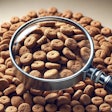
Scientists reviewed 20 studies on weight-loss diets for dogs and noted patterns in protein, fat, fiber and carbohydrate content in the dog foods. The researchers identified commonalities among effective hypocaloric diets or nutritional plans that provide fewer calories than needed for body weight maintenance. The basics of a hypocaloric dog diet are straightforward: a dog must eat fewer calories than it burns in a day while maintaining lean muscle mass. However, the details can be complicated and may intertwine with owners’ own beliefs about diet and nutrition. Scientists at the Pontifical Catholic University of Paraná in Brazil conducted a meta-analysis of published research to determine what factors make an effective hypocaloric diet for dogs.
“These findings offer valuable insights for optimizing hypocaloric diet formulations, facilitating an effective and health-promoting weight-loss process in canine patients,” the researchers wrote in the journal Animals. “This meta-analysis provides evidence-based nutritional recommendations on optimal caloric, protein, fiber, fat, and carbohydrate levels for hypocaloric diet formulations, supporting healthy weight loss and lean mass preservation in obese dogs. These findings contribute to the development of effective dietary strategies that enhance canine quality of life and longevity.”
Protein, fiber, fat and carbohydrates in weight-loss dog foods
The scientists identified guidelines for dietary formulations that facilitate weight loss while maintaining lean muscle:
- Protein (>25%): Diets rich in protein were associated with increased weight loss and lean mass preservation. Higher protein levels may support satiety and muscle retention.
- Fiber (>12%): Elevated dietary fiber intake contributed to weight loss by reducing caloric density and promoting gastrointestinal health. Fiber also modulates satiety, potentially enhancing diet adherence.
- Fat (<10%): Lower fat levels correlated with a more significant reduction in body fat percentage. Fat is the most calorie-dense macronutrient.
- Carbohydrates (<40%): Diets high in non-fiber carbohydrates were linked to weight gain, while lower carbohydrate levels supported fat loss and improved body composition.
- Caloric Density (<3.275 kcal/g): Diets with lower energy densities promoted greater body fat reduction without compromising lean muscle mass.
“The composition of commercial weight-loss diets for dogs, as used across studies, is highly variable, encompassing a wide range of caloric contents and differing levels of protein, fat, and fiber—nutrients critical for effective weight reduction,” the researchers wrote. “Currently, no standardized guidelines exist for these nutrient levels…”


















